top of page

Exploring the Jewel of Southern Africa: Unraveling the Wonders of Botswana
 Example of the tent we called home while we were here |  Mom and Shannon relaxing in camp |  Camp from the water |
|---|---|---|
 Decorative termite mound |  Firepit on the Water |  More from the deck |
 The Three of Us Together |  Enjoying Afternoon tea time together |
|---|
 Shannon and Mom at Dance Night |  Time to Dance |
|---|
 Wildlife visible from our Deck |  Delicious Food |  Dinner Outside on the Deck |
|---|
 Mom and Shannon on the Couch |  The Three of Us Together |
|---|
 The African Fish Eagle is a large species of eagle found throughout sub-Saharan Africa wherever large bodies of water with an abundant food source occur. It resembles the bald eagle of North America in Appearance. |  The bar-tailed godwit is a large and strongly migratory wader which feeds on bristle worms and shellfish on coastal mudflats and estuaries. The status of this bird is Near Threatened and its population is declining. The construction of seawalls and the reclamation of mudflats have led to a critical reduction of food supplies for migrating birds. |  The bateleur is a mid-sized eagle and large raptor. |
|---|
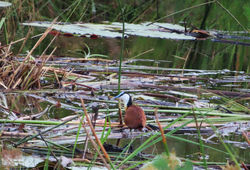 The African Jacan is a wader with long toes and claws that enable it to walk on floating vegetation in shallow lakes. |  African parrots flying in a large group seemed to be having the best time together. |  The Blacksmith Lapwing has red eyes and bold pied plummage possible warning colors to its predators. |
|---|---|---|
 Hawk on alert |  A coucal is one of about 30 species of birds in the cuckoo family. All members of the genus are sex role reversed. The smaller male provides most of the parental care. |  Glossy Starlings |
 The go-away-birds are named for their go-away call. It sounds like that is what they are saying. |  |  These guineafowl are particularly well suited to consuming massive quantities of ticks which might otherwise spread Lyme disease. Their bodies are well suited for running and they are very successful in maintaining stability over rough terrain at speed. |
 This bird has approximately 12 feather colors in a variety of patterns across their body. |  The National Bird of Kenya | 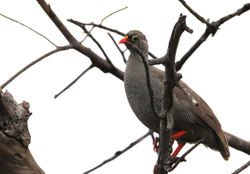 Red-billed Spurfowl |
 Woodland Kingfishers |
 The anhinga, sometimes called snakebird is a water bird. When swimming only their neck appears above water so the bird looks like a snake ready to bite. |  This is an intermediate sized egret. |  Colorful Duck |
|---|---|---|
 Birds of a feather sticking together |  Beautiful Cranes |  Egyptian Goose |
 The calls of Hadada Ibis are considered to be a sign of impending rains. When they fly continually, they are said to foretell a rich harvest in that year. |  Saddle Billed Stork |  Saddle Billed Stork and Little Friend |
 Spur Winged Goose |
 This is the largest owl in Africa measuring up to 26 inches in length. It's a resident primarily of dry, wooded savanah. It is mainly grey in color and is distinguishable from other large owls by its bright pink eyelids, a feature shared with no other owl speies in the world. |  Check out the Pink Eyelids |  This is another name for the Milky Eagle Owl. |
|---|
 The African Wild Dog is also known as the Painted Dog due to the variety of colors in their fur. |  It's estimated that there are about 6600 adults living in 39 subpopulations that area all threatened by habitat fragmentation, human persecution and disease. The largest subpopulation probably has less than 250 individuals. The African Wild dog has been listed as endangered since 1990. |
|---|
 As a group these animals can get into some trouble. This was obvious when they managed to get into some of the housing opening everything that interested them. They enjoyed drinking and spraying sodas around as well as throwing around the belongings of all the human inhabitants. They went to far when they ate a whole bottle of Tums. Evidence of that mishap was all over camp. |  Adult baboon |  Baboons in a palm tree |
|---|
 Baboons in the tall grass |  Baboon close up |  Baboon with baby in pouch |
|---|---|---|
 Baby baboon riding piggyback?? |
 The Chacma baboon is an omniverous highly opportunistic feeder, and will eat practically anything. Typical foods include fruit, seeds, grass, blossoms, bulbs, bark, insects, spiders, worms, grubs, rodents, birds, small antelope and funghi. The chacma baboon usually live in social groups, called troops, which are composed of multiple adult males, adult females and their offspring. The troops are characterized by a dominance heirarchy. Female ranking is inherited through the mother and remains rel |  Baboons enjoying the morning sun |  Baboons are great climbers |
|---|
 Solitary Elephant |  Elephants enjoying what is left of some trees |  Elephants' large ears help to reduce body heat; flapping them produces air currents and exposes the ears inner sides where large blood vessels increase heat loss during hot weather. |
|---|---|---|
 Noble Elephant |  Elephant Getting a Drink |
 Tiny baby elephant that the guide guessed to be approximately a week old. |  Protective Elephant Herd |  Elephants with a Baby |
|---|---|---|
 The African bush elephant is the largest terrestrial animal. They live in family units comprising several adult cows, their daughters and subadult sons. Each family unit is led by an older cow also known as the matriarch. After puberty male elephants tend to form close alliances with other males. although females are the most active of African elephant groups, both male and femaie elephants are capable of distinguishing between hundreds of different low frequency infrasonic calls to communicate |  Close up with Ears Wide |  New Baby Elephant |
 Elephants Crossing the Water in the Evening |  Elephant eating Water Lily Roots in the Water |
|---|
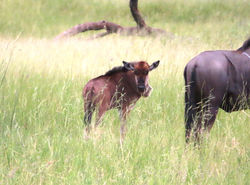 Today we spotted this baby wildebeest more of a reddish brown in color compared to the darker more black looking adults. |  Wildebeest Herd |
|---|
 The black wildebeest is a herbivore whose diet consists mostly of grasses. They are fast runners and communicate using a variety of visual and vocal communication. The natural populations of black wildebeest endemic in South Africa were almost completely exterminated in the 19th century due to their reputation as pests and and the value of their hydes and meat, but the species has been reintroduced widely from captive specimens both in private areas and nature reserves. | 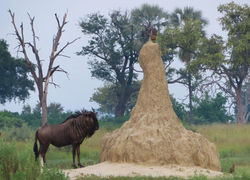 Wildebeest and Termite Hill |
|---|
 African Baobabs often grow as solitary individuals and are large and distintive elements of savanah vegetation. They grow from 16 to 82 feet tall and 33 to 46 feet wide. They store water in their trunks and branches on a seasonal basis. |  Botswana is 84% flat terrain. It is also home to the Okavango Delta. The delta is a UNESCO World Heritage Site as one of the few interior delta systems that do not flow into a sea or ocean, with a wetland system that is largely intact. It is produced by seasonal and spreads over the delta area for four months - March through June.The high temperatures of the delta causes rapid transpiration and evaporation resulting in three cycles of rising and falling level. The flood peaks between June and A |
|---|
 The roan antelope is on eof the largest species of antelopes in the world. They live in small groups and form harem groups of 5 to 15 animals with one dominant male. |  Impala |  Nyala |
|---|---|---|
 Red Lechwee |  Red Lechwee side view |  Tsessebe |
 Waterbucks with Bullseyes |
 Greater Kudu |  Kudu Pair |  Male Kudu with Huge Antlers |
|---|
 Can we ever get enough of beautiful sunrises only seen by rising before dawn? |  Rays of sun streaming through the clouds |  Sun on the horizon |
|---|---|---|
 Could one ever get enough of this natural beauty? |  Sunrise on the savanah |  Rainfall in the Distance |
 South Afircan giraffes are herbiverous. They feed on leaves, flowers fruits and shoots of woody plants such as acacia. In 2016 the giraffe was moved to Vulnerable status in the Red List of Threatened Species report. That means that the animal faces extinction in the wild in the medium term future if nothing is done to minimize threats to its life or habitat. South African giraffes are uncommon in captivity. |  Giraffe eating in the trees right at camp |  Check out those Giraffe Eyelashes - to Die for |
|---|---|---|
 Giraffe Duo |  Love this photo with necks crossed |
 Warthogs are abundant in Africa with their favorite habitats being grasslands, savanah and woodlands. They live 12 to 15 years in the wild. They have two sets of tusks that oritrude from the mouth and curve upwards. They use them for diggin, fighting and defense. |  Warthog Giving Friends a Ride |
|---|
 After elephants and rhinos the hippopotamus is the next largest land mammal. Despite their pysical resemblance to pigs the closest living relatives to the hippopotamus are whales, dolphins, porpoises etc from which they diverged about 55 million years ago. They are along the most dangerous animals in the world due to their aggressive and unpredictable nature. |  Hippo at the Water Hole |  Here's Looking at You! |
|---|
 Hippos Grazing |  Not so Happy Hippos |
|---|
 The lion is a large cat native to Africa and India. It has been reduced in numbers to fragmented populations in sub-saharan Africa and one population in western India. It has been listed as Vulnerable on the IUCN Red List since 1996 because populations in African countries have decreased by about 43% since the early 1990's. Although the cause of the decline is not fully understood habitat loss and conflict with humans are the greatest causes for concern. | 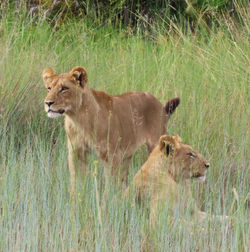 A pair of lions |  Lion pair |
|---|
 Lion following a Big Meal |  Male Lion after his Lunch |  Male Lion showing Signs of Some Hard Fought Battles |
|---|
 Engaging Lion |  Standing Lion |  Showing some Teeth |
|---|---|---|
 Beautiful Lioness |
 Zebras and Geese at the watering hole |  Burchell's zebras live in small family groups. These can be either harem or bachelor groups, with harem groups consisting of one stallion and one to six mares and their most recent foals,and bachelor groups containing two to eight unattached stallions. They often congregate in larger groups around water or feeding areas but maintain their family group. They migrate in a north south route the longest distance of any terrestrial animal in Africa, making a round trip of 300 miles (500 kilometers). |  Zebras with a baby |
|---|---|---|
 Zebra Duo |  Three of a Kind but None Exactly Alike |
 High Tea |  Time for Tea |
|---|
bottom of page